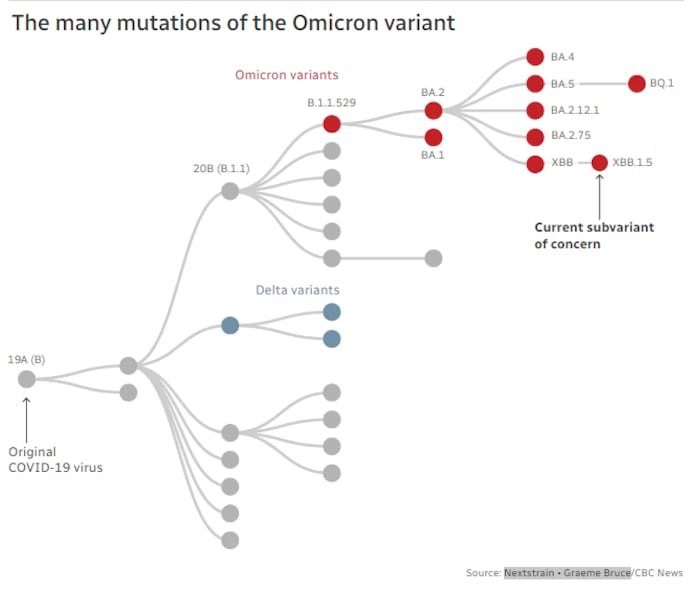- Home
- Health
Why XBB.1.5 — the latest Omicron offshoot — could ’outcompete’ other COVID-19 subvariants

A colourized electron microscope image of SARS-CoV-2, the virus behind COVID-19. Scientists are now watching the Omicron subvariant XBB.1.5, which is on the rise in multiple countries, including the U.S. (U.S. National Institute of Allergy and Infectious Diseases)
Photo: U.S. National Institute of Allergy and Infectious Diseases
Subvariant rising rapidly in U.S., identified in 25 countries including Canada
It's been a year since Omicron burst onto the scene, spiking COVID-19 case counts to new heights and dramatically changing the trajectory of the pandemic.
Since then, the variant has spawned a family of highly transmissible cousins. Some have fuelled rolling waves of infections; others largely disappeared.
Most recently, multiple mutated versions of the original Omicron seemed locked in a delicate dance for dominance.
In the U.S., there's now a likely winner: XBB.1.5.
The Omicron offshoot is rising rapidly south of the border, and the U.S. Centers for Disease Control projects it will soon hit roughly 40 per cent of COVID-19 cases (new window). Meanwhile, surveillance data in the U.K. suggests it represents 1 in 25 COVID-19 cases (new window), and could eventually become the next dominant strain.
The situation in Canada is more murky, given delays in data collection from across the provinces over the holidays.
At this time, it is too early to tell if the XBB.1.5 variant is growing in Canada,
the Public Health Agency of Canada (PHAC) told CBC News in a statement on Tuesday.
A day later, PHAC said it is aware of 21 detections of XBB.1.5 in Canada — though the full tally, based on the latest-available provincial and regional surveillance, appears slightly higher.
- SECOND OPINIONOmicron completely changed the pandemic. Are we prepared for what's next? (new window)
As of Wednesday, 12 cases of XBB.1.5 had been detected in B.C. in the Vancouver Coastal Health and Fraser Health regions, according to the B.C. Provincial Health Services Authority, while Art Poon, a professor in viral evolution and bioinformatics at Western University, said he knows of 24 genomes classified as XBB.1.5 that have been submitted nationally to date.
Those were largely sampled from Ontario, plus one from Nova Scotia and a few from Quebec — representing only a small fraction of infections.
But that could change.
I would expect that it will eventually outcompete the currently predominant BA.5-derived lineages in Canada,
Poon wrote in an email to CBC, although there are other lineages that we expect to grow in frequency as well.

The many mutations of the Omicron variant.
Photo: Nextstrain • Graeme Bruce/CBC News
Identified in 25 countries
XBB.1.5 was first detected in October, according to World Health Organization (WHO) officials, and has since been identified in 25 countries.
The SARS-CoV-2 subvariant evolved out of Omicron's BA2 offshoot, making it one of the latest members of a family tree that's incredibly branched and tangled and confusing,
said Angela Rasmussen, a virologist with the University of Saskatchewan's Vaccine and Infectious Disease Organization.
What's particularly unusual about XBB.1.5 — and what makes it worth watching — is its mash-up of mutations.
XBB.1.5 is a sublineage of XBB, which emerged through recombination. That process can take place when someone is infected with different variants of the same virus, giving those pathogens the chance to mutate together within the same host.
Basically, it's an evolutionary opportunity that involves cut-and-pasting those two virus genomes together,
Rasmussen said.
WATCH | New subvariant on the rise in U.S.:
New COVID-19 subvariant on the rise in U.S.
1 day agoDuration1:48A new COVID subvariant, XBB 1.5, is surging in the U.S. with health officials predicting it will make up close to 40 per cent of cases soon. Though its mutations make it easier to catch and spread, experts are cautioning people not to panic.
In the case of XBB.1.5, there could be evolutionary advantages on several fronts, said Rajendram Rajnarayanan, assistant dean of research and associate professor at New York Institute of Technology College of Osteopathic Medicine at Arkansas State University who has been tracking the subvariant's spread.
That could include mutations that help the subvariant latch on to human cells, while sneaking by the frontline defences of our immune systems.
It's the best of both worlds,
he said.
Speaking to international media on Wednesday, Dr. Maria Van Kerkhove, the technical lead for the COVID-19 response at the WHO, said the organization is concerned about the subvariant's growth advantage and apparent ability to escape immunity, adding it's now rapidly replacing
other circulating variants in multiple regions.
There's no indication disease severity has changed, she added.
There's still plenty of research needed to understand exactly how this subvariant operates — and to determine whether it'll spike global case counts, or simply fade away like some of its predecessors.
At this time there is no alarm,
said researcher and variant tracker Fiona Brinkman, from Simon Fraser University's department of molecular biology and biochemistry, in an email exchange, but we are definitely cautiously watching this and other variants that are showing signs of having key mutations.
What's concerning, multiple experts agreed, is that the early signals do suggest it could lead to an increase in infections of some level, at a time when hospitals are already under immense strain.
Updated vaccines expected to hold up
Even if XBB.1.5 doesn't cause more severe illness, it could still lead to re-infections, while preying on the vulnerable and under-vaccinated.
A lab-based study from a team at Columbia University, published in the medical journal Cell (new window), suggests XBB.1 — the direct predecessor to XBB.1.5 — was among the least likely Omicron subvariants to be neutralized by antibodies in the blood of previously infected or vaccinated individuals.
Newly emerged subvariants could further compromise the efficacy of current COVID-19 vaccines and result in a surge of breakthrough infections as well as re-infections,
the team wrote.
However, it is important to emphasize that although infections may now be more likely, COVID-19 vaccines have been shown to remain effective at preventing hospitalization and severe disease, even against Omicron as well as possibly reducing the risk of [long COVID].
WATCH | XBB.1.5 reported in 25 countries, WHO chief says:
New COVID-19 virus subvariant now in 25 countries, says WHO chief
23 hours agoDuration0:33A new subvariant of the coronavirus, XBB.1.5, is increasing in the U.S. and Europe and has been found in 25 countries, says the World Health Organization.
Updated bivalent COVID-19 vaccines appear most useful at preventing serious illness from ever-evolving Omicron cousins, another small study suggests.
Individuals who received a BA.5-based bivalent booster had better neutralizing activity against all Omicron subvariants — especially against BA.2.75.2, BQ.1.1, and XBB — than those who received either one or two of the older vaccines, a team of U.S. researchers recently wrote in a letter published in the New England Journal of Medicine (new window).
So that suggests that the bivalent boosters really do boost immunity to XBB.1.5,
Rasmussen said.
Still, she warned the subvariant could prolong a difficult respiratory virus season in Canada and beyond, if it takes hold.
Certainly there's the possibility that XBB.1.5 could contribute further to the surge that we've already been dealing with, in terms of the so-called 'tripledemic' or the grab bag of respiratory diseases that are affecting us right now,
she said.
But that's far from certain.
Tulio de Oliveira, director at the Centre for Epidemiology at Stellenbosch University and head of the South African Network for Genome Surveillance, said on Twitter that it's not the first time a recombinant with notable mutations has raised concerns — then fizzled out.
A similar situation emerged in South Africa last August, he tweeted (new window), involving XAY — a Delta and Omicron mash-up — which initially concerned local scientists before eventually fading away.
The rise of XBB.1.5 already appears to be linked to higher COVID-19 hospitalizations in certain U.S. regions in the northeast, which raises concerns about how to protect both patients and health-care workers from infections, noted Rajnarayanan.
Still, he said the spike may simply be tied to recent holiday gatherings and travel.
So we have to wait a few weeks to see, is it going all the way, straight up? Or is it going to stabilize like what we've seen with BA.5 and other Omicron subvariants?
Lauren Pelley (new window) · CBC News ·




